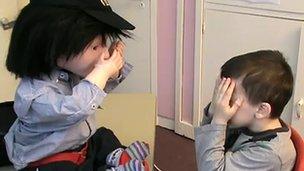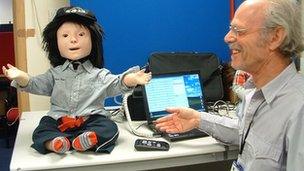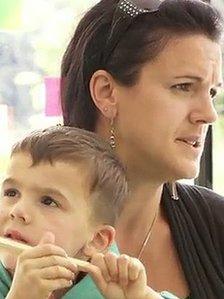Robot at Hertfordshire University aids autistic children
- Published

Children with autism learn responses from the robot through games and interactive play
The profoundly autistic boy pokes fingers into the eye sockets of robot Kaspar and then moved them to the empty mouth.
The robot feigned hurt, covering his face, and the boy copied the gesture.
He rocked back on his seat and his fingers then went to his own eyes and mouth as if discovering them for the first time.
"If the boy had tried to do that to his own brother, sister or parent then there would have been an instant reaction," computer science senior researcher at the University of Hertfordshire Dr Ben Robins said.
"Children with autism have to live with constant negative feedback," project leader Prof Kerstin Dautenhahn said.
That means they are constantly told off or criticised for what they do.
In pictures: Robot teaches autistic children
Several robots are being used by the university in schools to explore ways of teaching profoundly autistic children social and communication skills.
At this time of year that means opening Christmas presents and appreciating what they have received.
It also means taking part in family activities. But for profoundly autistic children the season can be an ordeal. Too much activity often makes them withdraw into themselves.

Dr Ben Robins with Kaspar - short for Kinesics and Synchronisation in Personal Assistant Robotics
But the researchers do find success. Some children are able to express happiness and parents have seen remarkable changes in their children after interaction with the robot.
Others are looking forward to a more positive reaction this Christmas.
At the same time the university, at this time of generosity, is looking for funds as its own Christmas gift.
Although researchers have anecdotal evidence that interaction with the robot does create improvements they do not know if these changes are permanent.
They are also not totally sure that the robot has been influential.
Parents who report back to the researchers have said their children can for the first time experience happiness and know what the word means.
Reacting to touch
Others say their children are expressing affection for the first time.
However, there is still doubt that the robot's influence is direct and lasting. The children's repeated responses could be as a result of family interaction.
Dr Kathleen Richardson, from Cambridge University, said that the use of robots for a wide range of therapy could be just a fashion. She wants to see more independent assessment of the research.
The University of Hertfordshire aims to raise £1m to fund a detailed critical study of its work and to answer these questions.
Up to now the research team has been working with studies by other researchers around the world and their own observations.
Dr Robins said that when he took Kaspar to a school the children showed real delight. But he wants extra research to assess its significance.
He knows from studies done in Japan that making robots realistically humanoid only works up to a point. Too much realism can make the machine look like a "walking or talking corpse".
Kaspar is made from components bought off the shelf. Its clothes are from high street stores and his face mask is minimal - just eyes, nose and mouth.
The most expensive items are the sensors spread across the robot so that it can react to children's touch and express hurt or delight at having its tummy area tickled.
"Children playing with Kaspar like to be in control. They are often in pairs with one playing a dominant part at different times.
"The exercise is to promote interaction between the children with Kaspar as the facilitator or intermediary.
"However some children do not instantly get the situation so it is not a spontaneous response. Others try to take control and prevent the other child from taking part so we have to be cautious of this."

Parents have noticed improvements in their children
Dr Richardson said that she had run a parallel exercise with half of a group of children interacting with the robot and the other half playing with a toy crane.
She saw some similarities in the use of social skills in both groups.
"I think more research is needed and this will come when the university reaches its fundraising target and can carry out the in-depth study."
Dr Robins said most of the work had been done in classrooms. Researchers now need to study what happens in the children's own homes, how they react with siblings and parents.
But there have also been some dramatic successes. In one case a child with violent tendencies became placid with Kaspar and spent a long time gently stroking the robot.
Describing the robot, Dr Dautenhahn said: "We decided to give it a minimal expression, a simplified face and the ability to make expressions that could be easily understood.
"The neck was not covered and there were obvious clues that the robot was not humanoid so that it would not be confused as another person.
"Kaspar is a research tool with programmed responses adapted to be used by an autistic child in a safe, non-judgemental environment.
"Our aim was to make the child feel comfortable with the robot. The experience for many autistic children is to receive negative feedback. The robot makes predictable and positive responses which they can copy and learn."